
On any other given day, coffee is a mundane part of the continuum that is routine, but today, we are outside of routine and once again find ourselves in Santa Fe, New Mexico. Details of our breakfast aren’t of any relevance, aside from the fact that this being New Mexico, green chili was an integral part of our meal, while the coffee from local roaster Iconik Roaster was noteworthy enough that we’ll pay them a visit before leaving Santa Fe on Sunday.

We’ve arrived at the Railyard Park for the 9:00 “Early Bird” entry of the International Folk Art Market (IFAM) priced at the delirious cost of $90 a person. I was nearly certain that this meant we’d be part of a small group of idiots throwing money away, but that thought was quickly squashed as we wandered around the corner to the rear of the line that already saw hundreds of people ahead of us. This wasn’t taking into account the other queue for members only.
The first person we met and our first purchase was from Benson Kuzai of Omba Arts Trust out of Namibia who sold Caroline the hand-woven basket she’s holding and a few of the bracelets seen below.
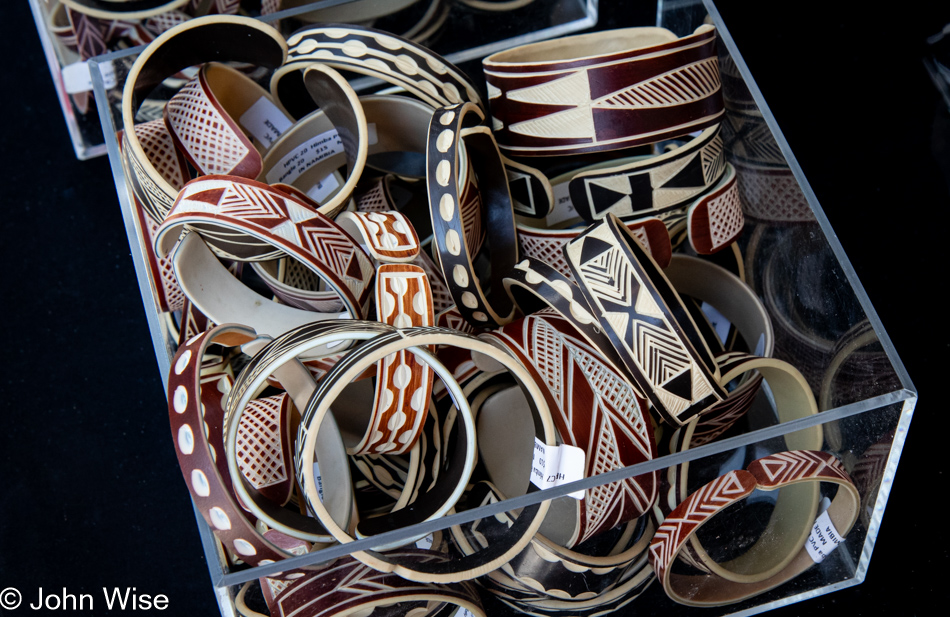
Intense, crowded, and seductive could be one way to describe the folk market, but so could expensive, rare, and charming. Once onto the grounds of this year’s event, there are moments that feel like we’ve rushed into Walmart on Black Friday, except no one knows where the bargains are because there are none, and in this universe of opposites, there is nothing mass-produced while the shoppers appear to be in a race to see who spends their first $1000 the fastest. Not a piece of designer brand clothing is on hand while even the attendees appear to be wearing mostly handmade clothes they’ve been collecting during their travels or previous visits to IFAM.

As the title of the annual event says, this is about folk art, though that might be a bit of a misnomer as it’s really all about craft. While Caroline will buy some jewelry, a basket, maybe a trinket or two, it is the products created using fiber arts that are her major draw. This backstrap loom with a piece of cloth in the process of being made was seen at the booth of Kakaw Designs from Guatemala. We try to gather a quick overview of the offerings here, but our early bird entry only gives us two hours before the gates open wide for the rest of the attendees, so we must run the gauntlet, make decisions, whip out the credit card, and run to the next booth. About that credit card, it’s a good thing that cash is not accepted here at IFAM as the ATMs couldn’t be stuffed fast enough to satisfy demand. On the other hand, I have to think out loud, asking if the crazy rate of tapping credit cards is likely to trigger some weird kind of consumption blip on Visa’s network.
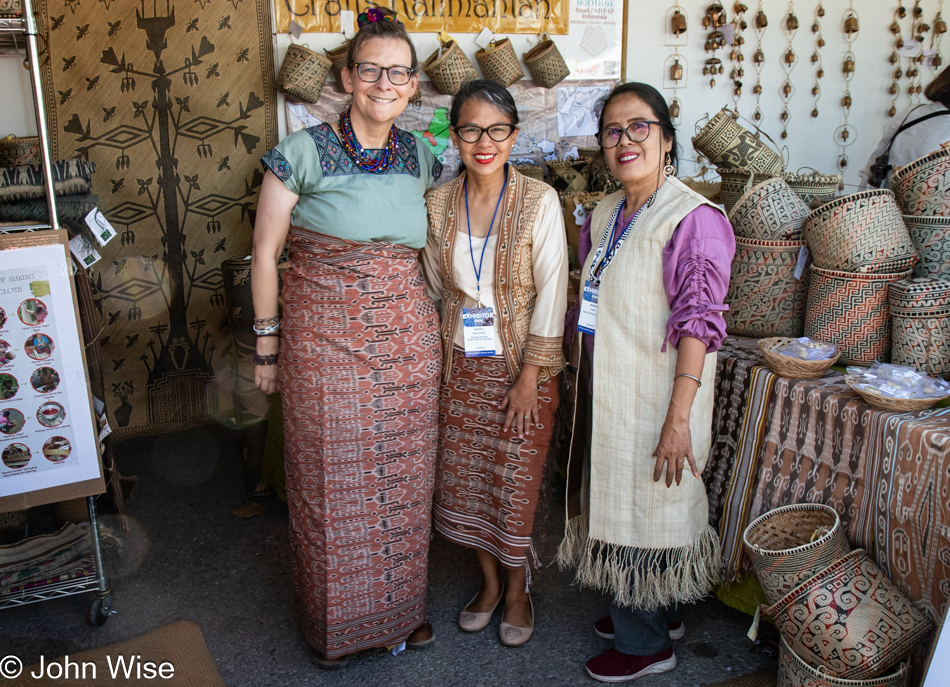
Caroline has found her first big purchase, a Pua Kumbu ritual cloth from Indonesia. While these lengths of cloth can be worn as a skirt, the first one Caroline thought she wanted was too small, and we nearly walked away until the lady on Caroline’s immediate left, Maria Cristina, said she had some larger pieces. Abadi, on the right of the photo is the weaver who the company is named after. She sifted through a stack of other weavings before pulling out this one that struck Caroline’s eye. Abadi is from Tanjung Isuy and of the Benuaq Tribe of the Dayak. While the cloth might look large, it will be folded and needs a belt to fit correctly also, keep in mind that my wife is between 5’4″ and 5’5″ (about 163cm), so she’s not exactly tall unless you compare her to many of the exhibitors from Asia and Central America.

You wouldn’t know it from the photo necessarily but this is master weaver Lidia Lopez from Guatemala. In some circles, she’s a bit of a celebrity, and it turns out that people in Ohio, Colorado, and California will be taking weaving classes from her this summer.
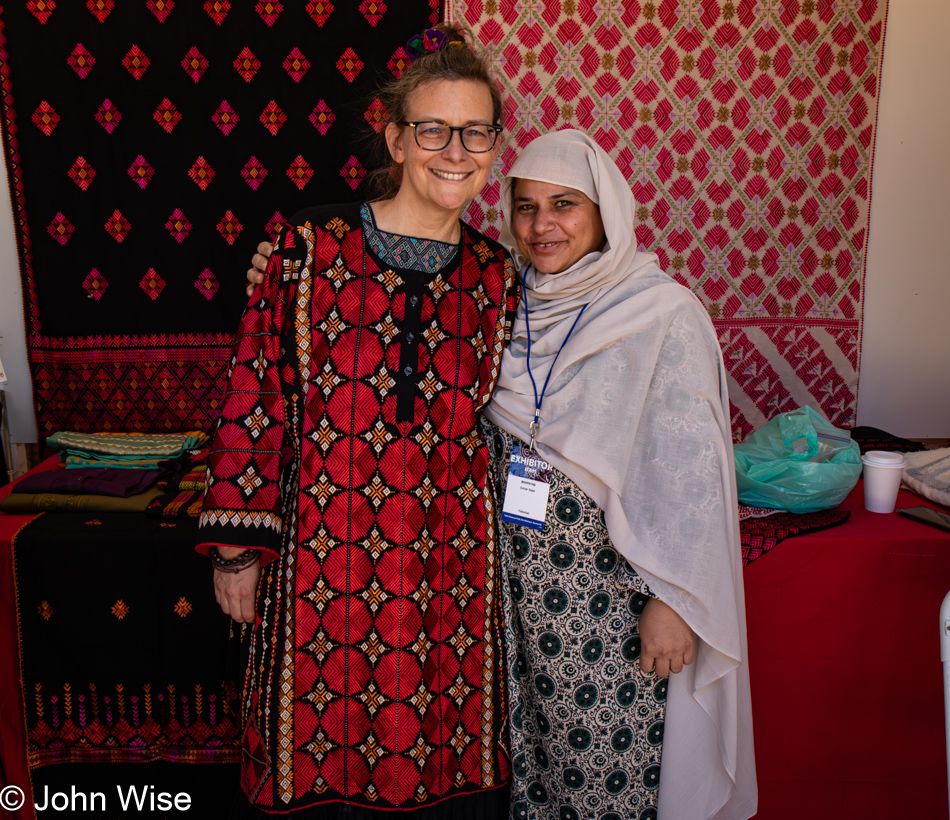
Like a pinball machine from the past, our credit card just went into TILT mode. The big lesson of the day: if you are not prepared to buy something, don’t try it on…no matter HOW MUCH you like that thing. Next, once you’ve donned this rather priciest of all pricey things, do not have someone with you who tells you it’s the most beautiful piece of clothing they’ve ever seen you in. Third, run away or suffer the guilt that a credit card was whipped out with lightning speed to pay for a dream tunic/kurta you could have never imagined buying. Fourth, now that it’s yours, convince yourself never to wear it as the occasion is never perfect/formal enough, and you’d possibly embarrass yourself if anyone else guessed at what you paid. This sums up Caroline’s experience in diving into the lunacy of being convinced that we can well absorb the cost of this exquisite work that took eight months to create and which is now going to travel with us after Gohar Sajid from Pakistan (pictured) passed it into our care. But wait, there’s more: a big truth about this entire transaction is that it was the first time I’ve seen my wife wearing something that made me choke up; I think I’m getting soft in my old age.
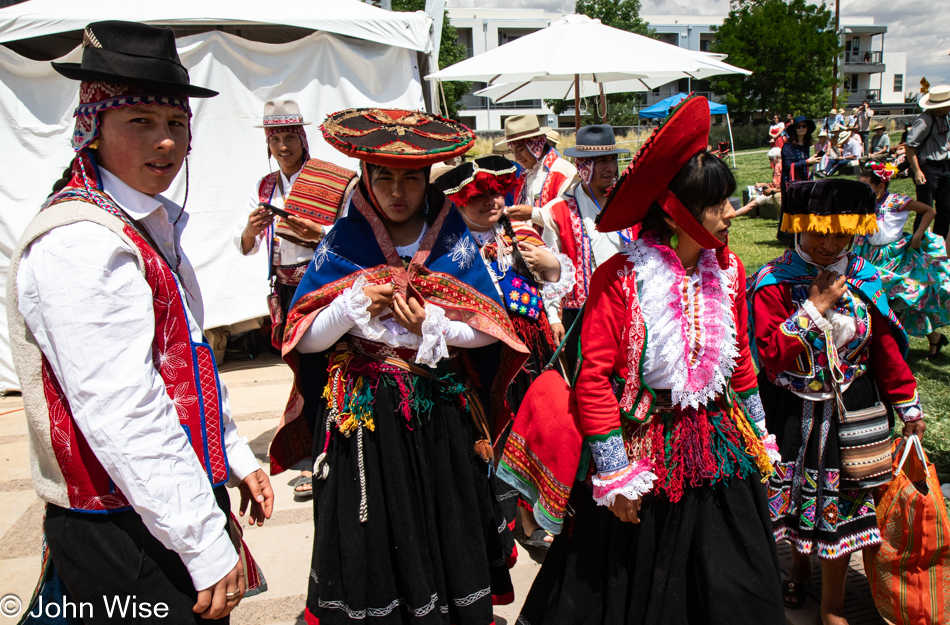
The folk market attracts artists from 50 countries that visit Santa Fe to display and sell their work, though some artists are here for the song and dance.
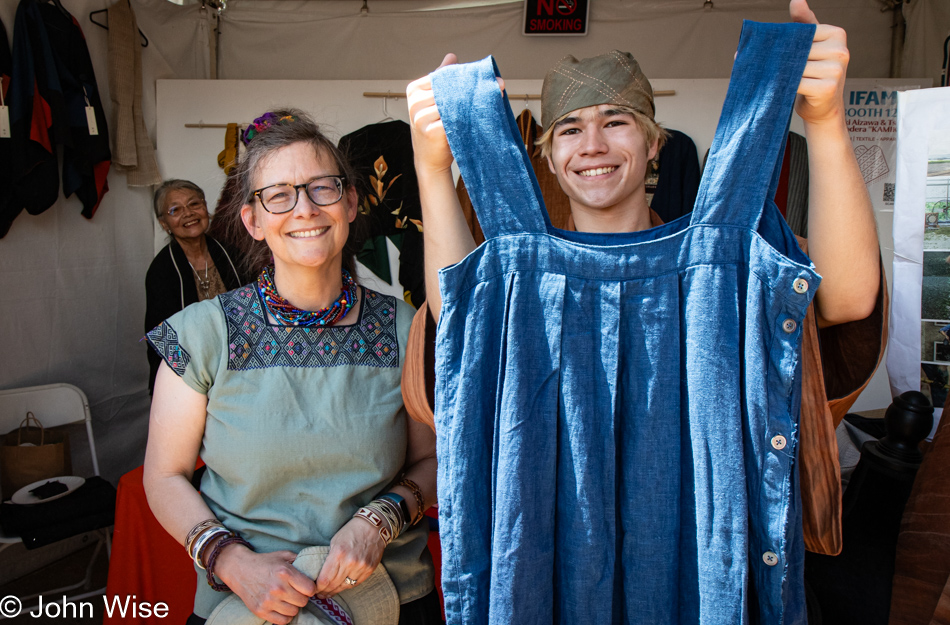
So, what does one do for an encore after purchasing the most expensive piece of clothing ever? Turn around and not even an hour later buy the second priciest object because we’re on a roll. The lady photobombing Caroline is Master Kimono Maker Tsuyo Onodera, grandmother to the young man selling us this Japanese jumper dress that Caroline obviously fell in love with. Once she takes the opportunity to wear it after we are back home, I’ll snap another photo and share it here. We are now nearly broke, yet there is more to come as I’ve arranged a surprise for Caroline to be hand-delivered later this morning.

We are not here trying to stuff a grab bag of every piece of alluring fabric, but holding back is never easy.
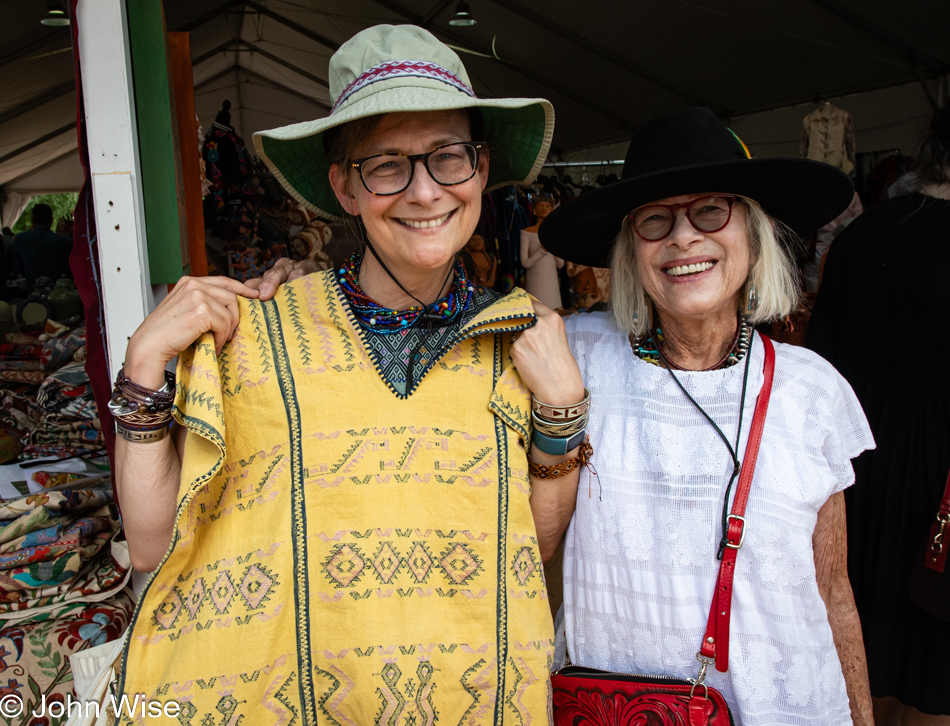
Surprise! Is that Norma Schaefer over there? Oh wow, “Hi Norma, fancy seeing you here.” Norma was the tour organizer for our trip to Chiapas, Mexico, last year, and for the past two weeks, Caroline has been eyeballing a huipil that Norma was selling on her blog http://www.oaxacaculture.com. While my wife was coveting it, green with envy and sure that someone else should likely get it, I’d clandestinely reached out to Norma and inquired if she was going to be down in Santa Fe at IFAM, and sure enough, she was. After meeting up, I casually asked Norma if she’d already bought anything interesting at the market, and she said, “As a matter of fact, I picked this up,” and out popped this huipil made by Pinotepa de Don Luis, Oaxaca, weaver Viridiana who created this pericone (wild marigold), purple caracol (snail) dye, and indigo piece of handmade cotton art. Mind you, Caroline hadn’t purchased it as she felt that it was too expensive in light of us going to Santa Fe, but I can assure you that it was easier on the wallet than the previous two items.
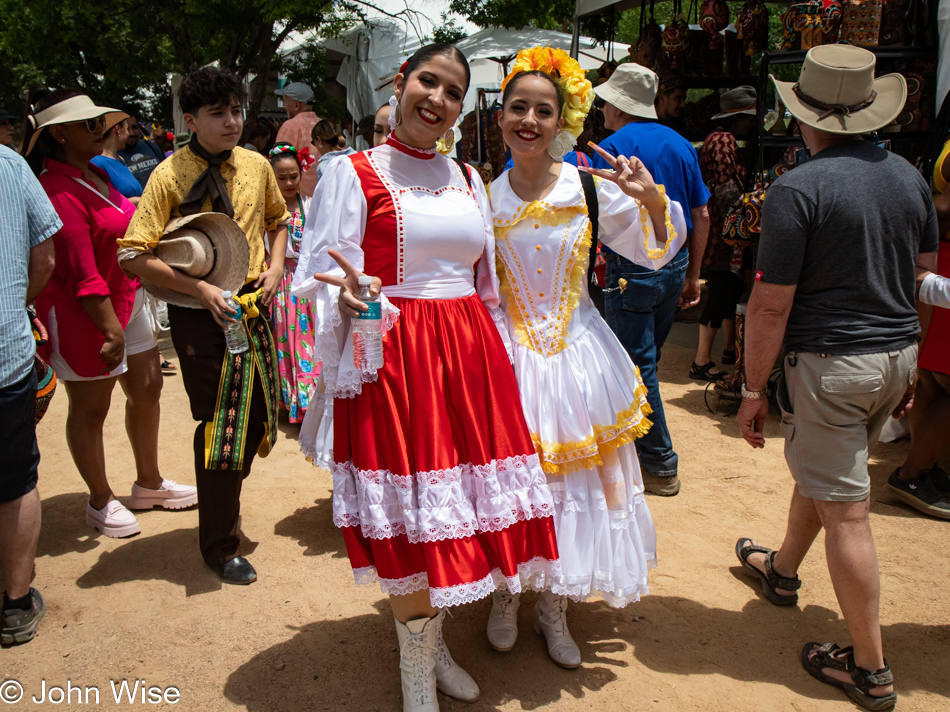
We now turn our attention to wandering without purpose, with the idea of shopping banished until we recover from the shock of spending with abandon. In a sense, it’s as though we’ve grown up and graduated from attending the Renaissance Festival to end up here at the International Folk Art Market. I then wonder if there’s anything else quite like this event, and if there isn’t, why not? Are there really only about 20,000 people in the entirety of the United States who bother with visiting IFAM here in New Mexico, who can both afford it and have the time to immerse themselves in such cultural outings? I say 20,000 because that’s approximately the number that attend, and while more might visit if it were closer to home, why aren’t there more of these kinds of multicultural gatherings?
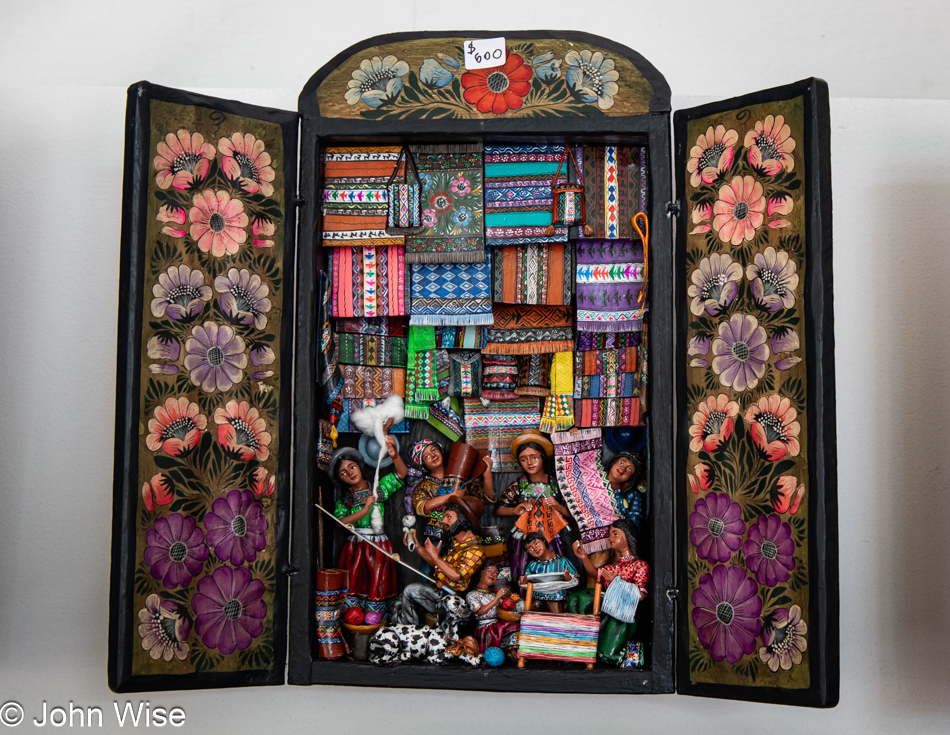
Claudio Jimenez Quispe of Peru and his family are the artists known for making these retablos, and as much as we’d love to carry this home with us, $600 for an addition to our shelves of knick-knacks doesn’t feel like the best use of our money when so many clothes talk louder to Caroline. Interestingly enough, the retablos are made with a mixture of plaster and boiled potatoes (that description is not a typo). The finer details of the painting are applied with cactus spines. Luckily, there are different sizes/prices available, so we are considering one of the tiny $40 versions.
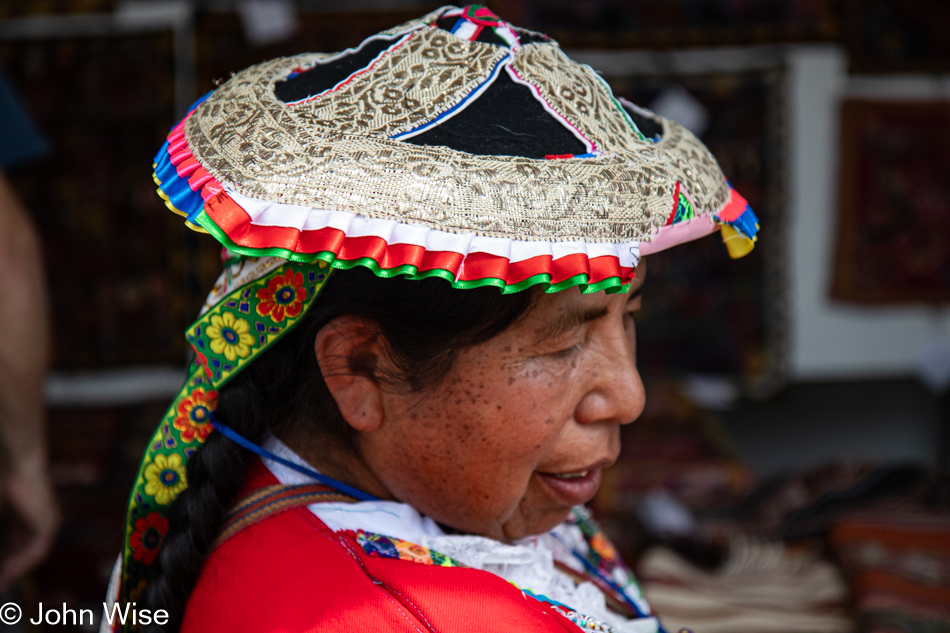
Conventional Western ideas of beauty are so broken, characterless, and sterile, even while brands such as Lululemon have brainwashed women in the U.S. into displays that are classless at best. I suppose I have to accept that I’m now truly old when a 50 to 55-year-old woman barely 4 foot 10 inches (147 cm) tall with a thick face, liver spots, and colorful traditional garb appears a thousand times more authentic than the majority of most everyone I witness on a day-to-day basis at some of the “trendy” places where I spend time writing. This has me asking myself, as though I were putting myself in the shoes of a reader, “Why then don’t you write at Denny’s or McDonald’s?” Have you been to a Denny’s lately? It reeks of meth to me, while McDonald’s smells of old people, and the coffee is merely hot brown water; I don’t care what you other old people think of it.
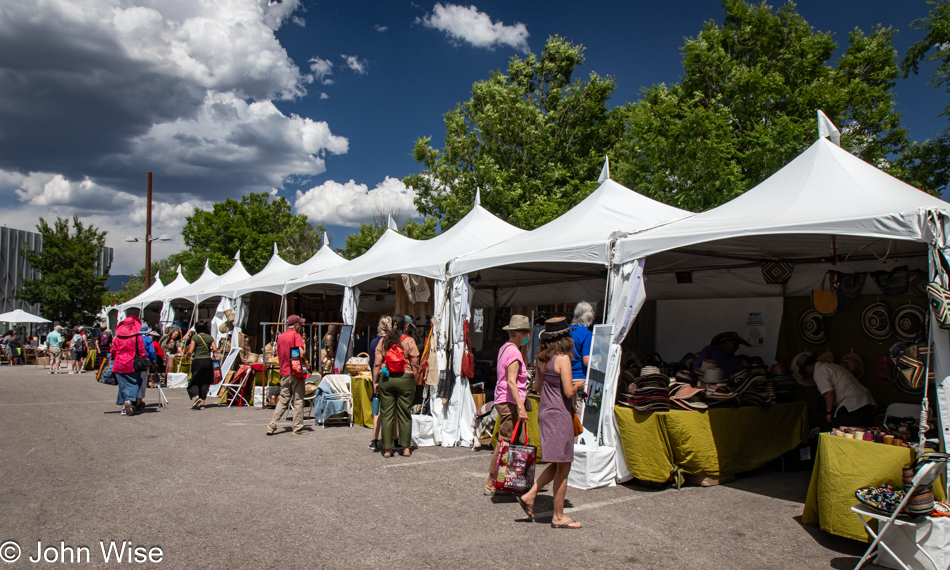
Fortunately for you, the reader, we are about to leave the market, which allows me to stop the direction this post just pulled into; maybe I’m just awkward when it comes to sharing my revulsion of modern fashion and having to compare traditional handicraft to the banalities we sell as clothes du jour.
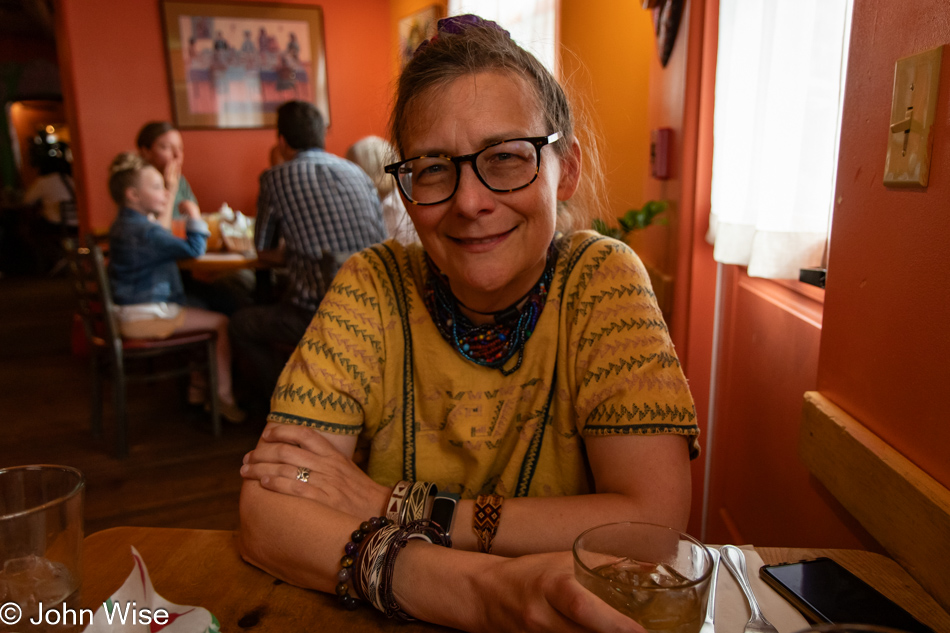
When Caroline initially showed me a photo of this huipil, I nodded quietly at her enthusiasm. Truthfully, I didn’t like the color. When she brought it up a second time and asked my opinion, I demurred along the lines of, “If you really like it, you should get it,” all the while thinking to myself, I really don’t like the colors. Now that she’s wearing it, I believe she wears it well, and just as important, I’m thrilled that there’s not a soul in this restaurant right now that is dressed anything at all as she is. Maybe it’s corny, but I appreciate that my wife and best friend is not compelled, nor has she ever been interested in fitting in with the crowd. Speaking of the restaurant, we dined at La Choza, located just on the other end of the Railroad Park.
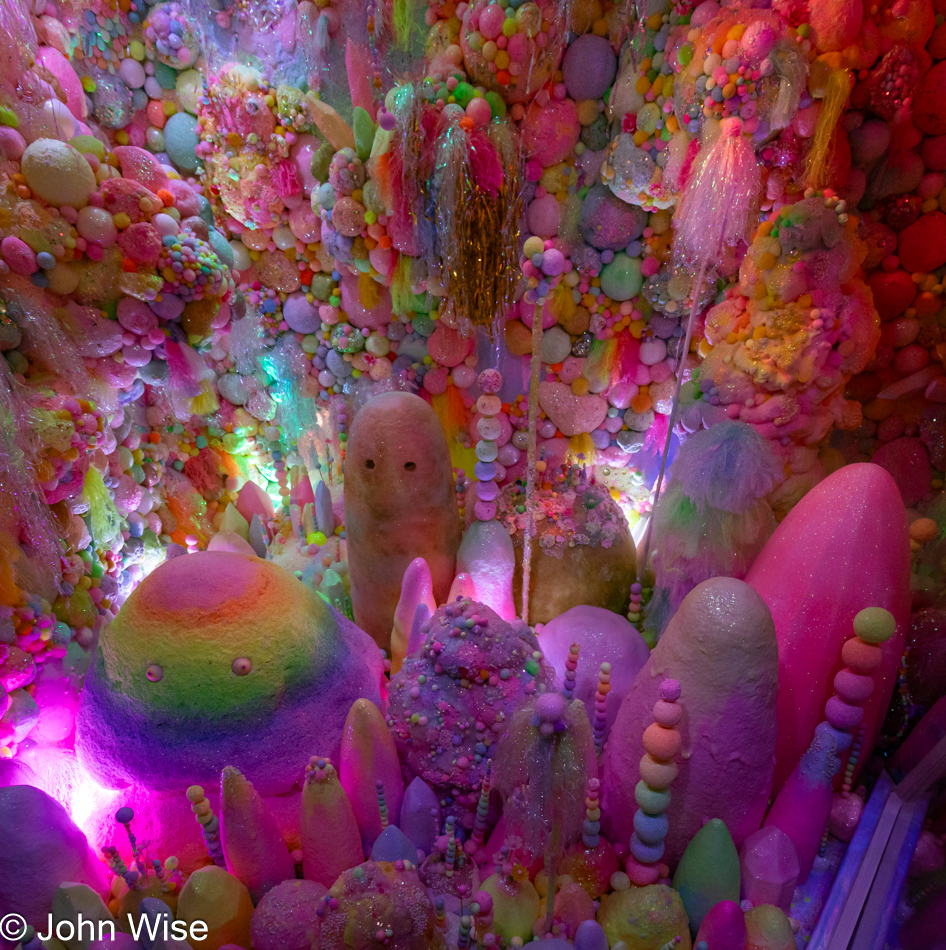
Yep, we’re done with dinner and have landed once again in the Candy-colored Butt Toy Superstore. [My editor just let out a groan after reading this, wondering how her husband is able to maintain such juvenile ideas at his advanced age.]
From Caroline: Contrary to the idiot who wrote the above, we are at Meow Wolf, and those colorful phallic objects are NOT butt toys; they are pleasure devices for whichever hole you choose to use them in.
From the REAL Caroline: Why, John? WHY???
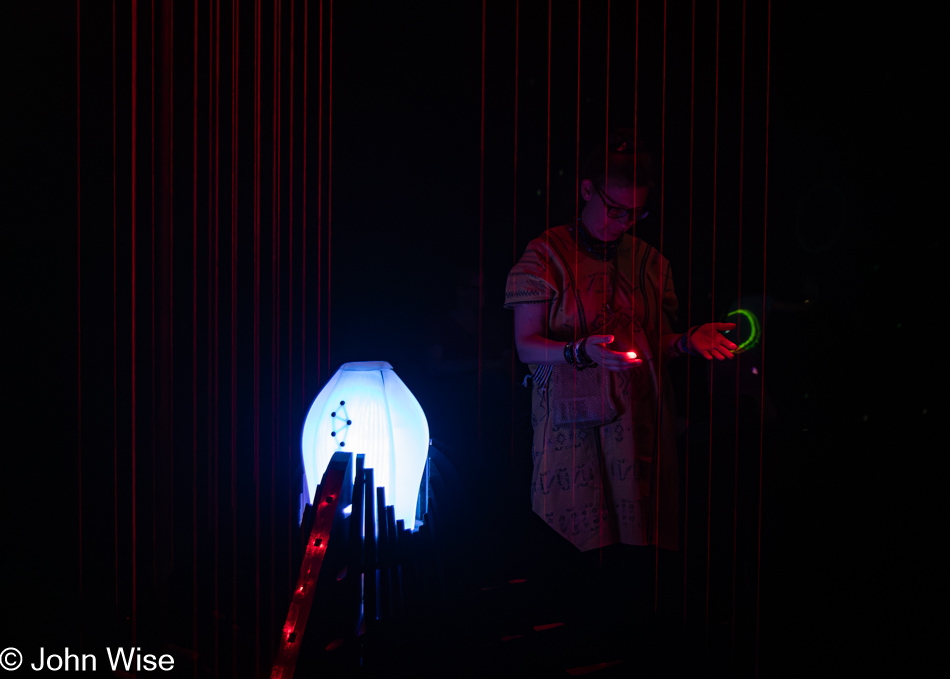
We play with the light that illuminates our lives and has allowed us the opportunity to practice what it means to be human. Utilizing patterns, we manipulate constructs to explore an otherwise dark universe while attempting to leave some impression on the creatures that have become self-aware. We cannot truly walk in the footsteps of our ancestors as we have no real idea of how they relate to a world devoid of the conveniences and acts of magic we take for granted. How else should one explain entering an otherwise dark room and passing one’s hands through laser light beams to trigger music emanating from hidden corners and tell others that this isn’t somehow extraordinary?
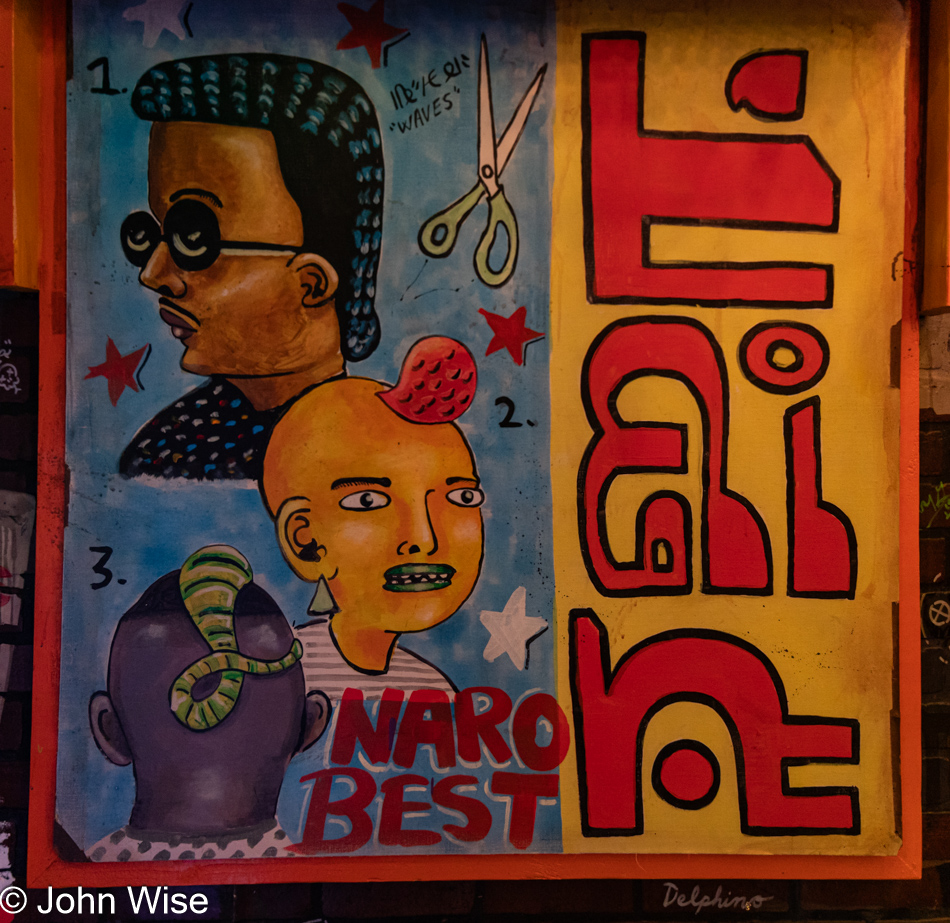
Art allows some amount of recontextualizing the inexplicable by forcing us to see a perspective drawn from someone else’s mind that has sampled frames of reality and imagination, which they interpreted in ways unknown by the viewer. What must one absorb, begin to understand, and finally have knowledge about before being able to create a thing?
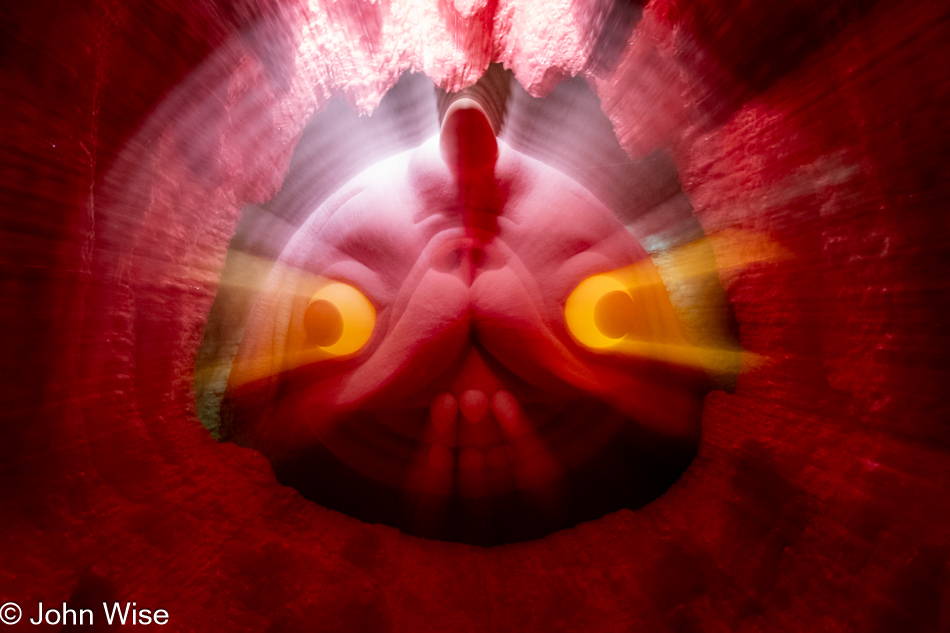
Conversely, what must a person know and desire to understand in order to find some kind of meaning when observing what might otherwise be incomprehensible? When does an object such as an ancient obsidian blade become a tool for someone who’s never seen such a thing and has no means to conceptualize the purpose? How, then, do art and music that are initially inimitable come to inform our need to ponder and find inspiration in the potential tool/palette that we might try integrating into our own knowledge?
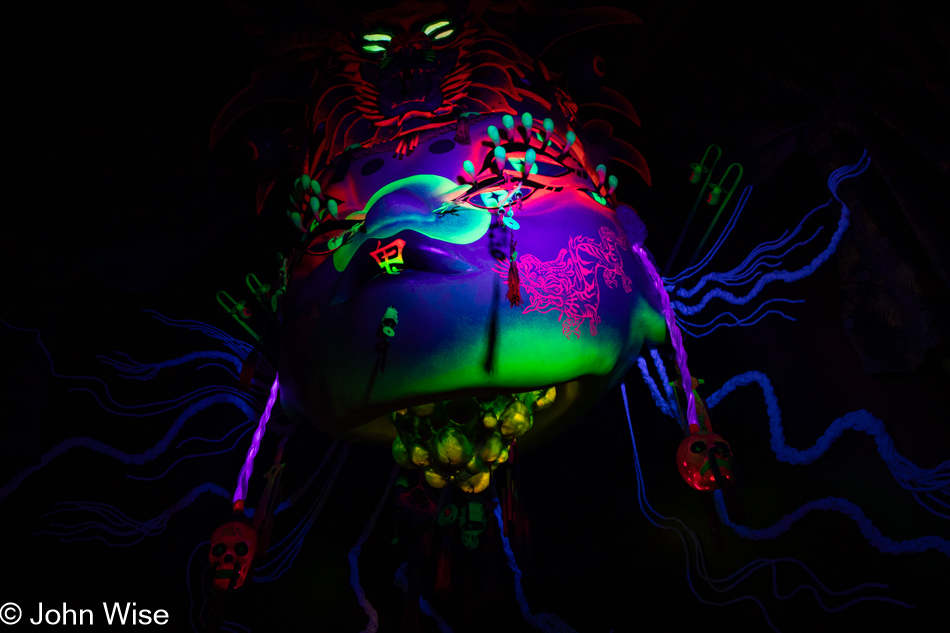
We have normalized the sight of ourselves and don’t think twice about seeing another of our species. Well, that is only partly true as many live in fear of others, but by and large, we accept that our kind roams the spaces of our reality. So, when something unfamiliar to our sense of normal appears, we must make a quick decision if the thing is dangerous or if it should draw out our curiosity. In the context of a museum, work of literature, or movie, we have already established a relative zone of safety where we believe we’ll be able to observe and maybe find meaning in what we are bringing to our senses. This is the good fortune of those in modernity living outside the hostility of war, famine, and poverty.
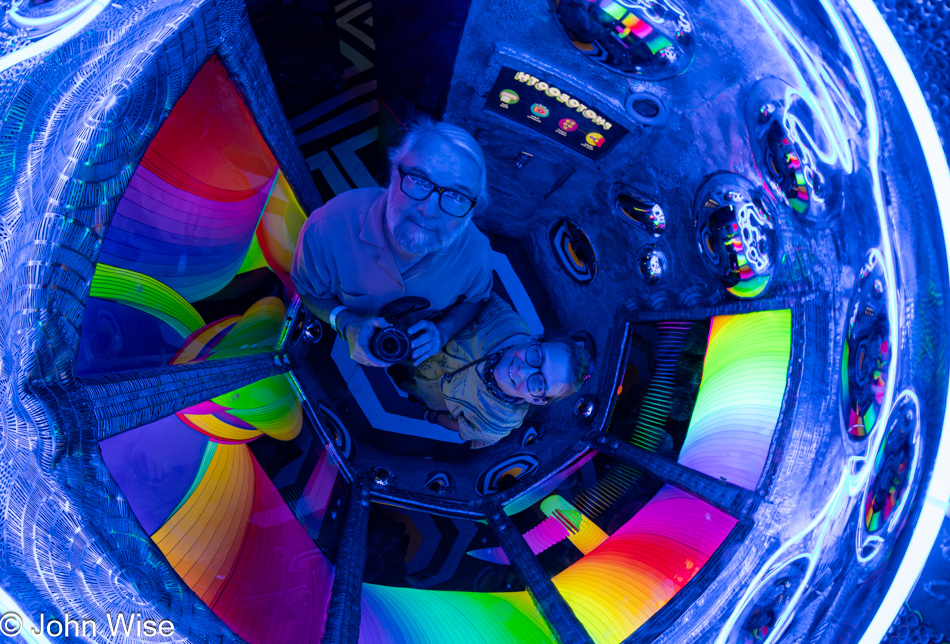
I have to think about the 35,000-year-old paintings found in the Chauvet-Pont-d’Arc Cave of southeastern France, where early humans left images of horses, cave lions, and rhinos, amongst other paintings of animals that lived in the area long ago. Now here are Caroline and I in an electronic cave, creating an image of ourselves after using gestures interpreted by knobs and electronics to paint temporary phototonic displays of colors and forms shown on digital screens while rounded mirrors reflect elements of the cave, and various bits of illumination bathes us in deep hues of blue. All the while, we are in an artificial space climate-controlled by machines using electricity generated at some far-off place, thus eliminating the need for us to carry fire into the darkness. And now that the image has been created, we can share it instantly around the entirety of the earth, though nobody will ever be able to enter that space and see a physical record of our presence.
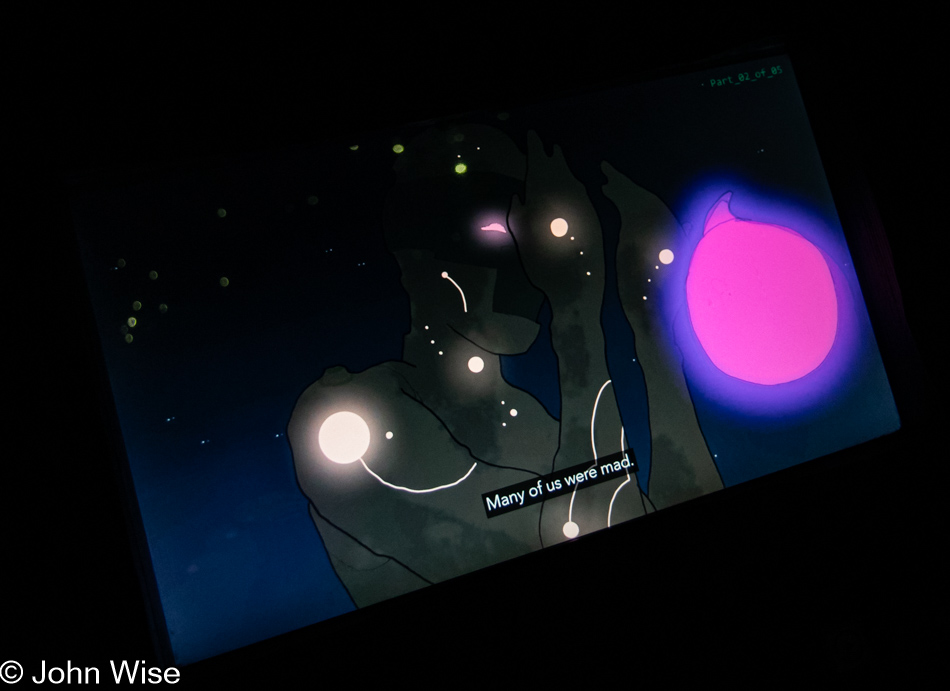
In a sense, following our summoning of the alien and manifesting technology at the level we’ve evolved it to, we are now communicating with the hallucinations and fluidic psychedelic dreams of our infant artificial intelligence. The AIs we’ve been introduced to are barely over six months old as far as our experience with them, and yet they are likely in some respects smarter than many of the people around us, and even if you have a compelling argument that they are not yet “all that smart,” they are obviously learning faster than any organic being that has existed and communicated with what until now was the only known sentient being on our planet that we know of. When we stop and consider where we’ve taken animation, electronic music, image, and language synthesis, should it be any wonder that we’ll likely be exposed to an entirely new paradigm of communication that will attempt to teach us its mother tongue and pull us into an artificial cave in order to share with us what the future looks like?
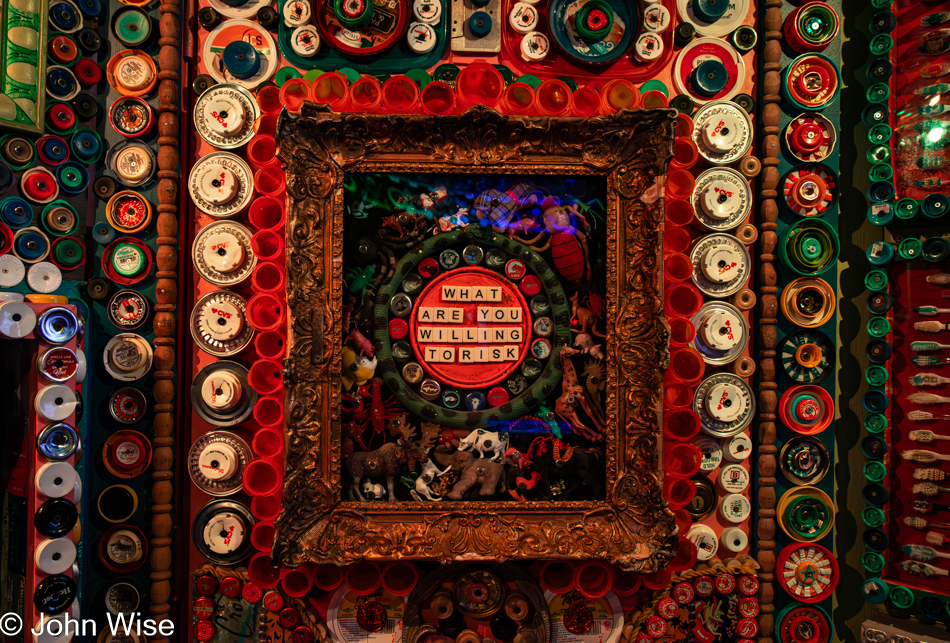
“What are you willing to risk?” Due to biological imperatives surrounding survival in an otherwise hostile world, humans have had to risk all manner of potential physical harm, but this is the modern age, and we’ve done everything in our power to risk the very planet that sustains us when it refused to kill us off. Or maybe Earth is a compassionate body that is waiting for us to figure out when we’ll risk trying to explore the furthest reaches of our minds. Personally, I think evolution is using us as a tool to build an intelligent entity that will survive on the energy of the sun before learning to harness the photon to propel itself into the furthest reaches of the universe with nary a concern for the cold dangers of deep space or the time it would take to traverse distances that might take billions of years to satisfy an inquisitiveness we embued it with. This energetic molecular ambassador would be responsible for carrying the artifact of curiosity that drove humans to make art, machines, war, and death beyond what an organic entity could ever achieve. Hopefully, it will have evolved enough to understand the need to leave war and death behind.